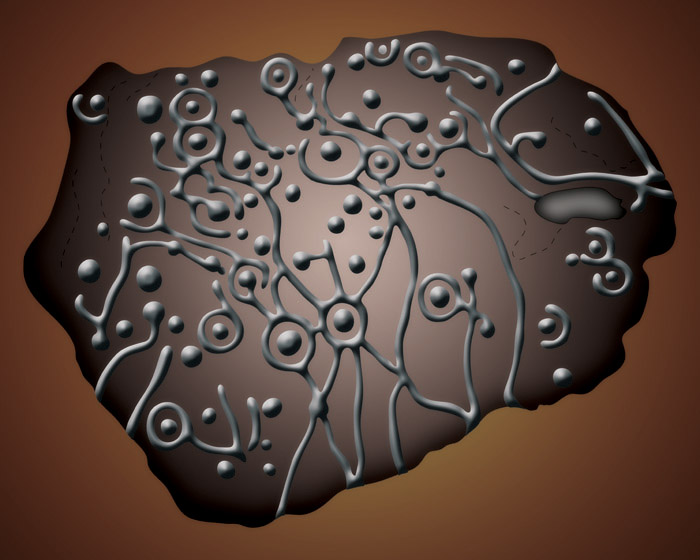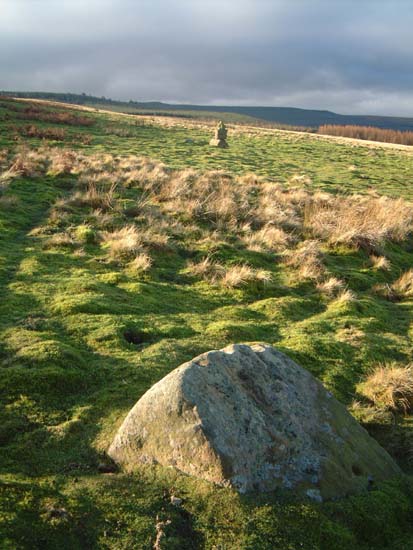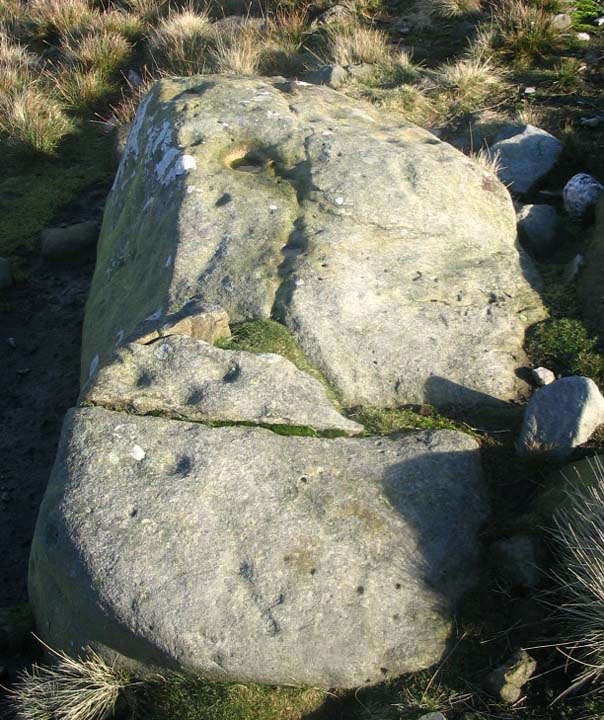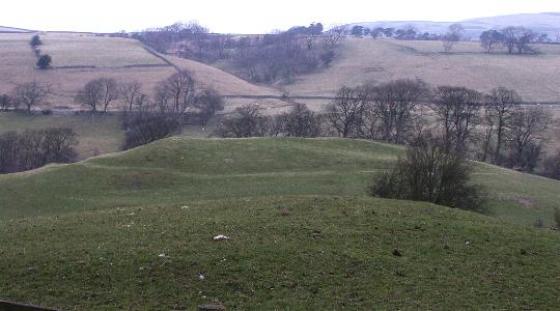



The Stroudystone, view towards Osmarill/Osmonds Gill

14-9-2008
www.briankerrphotography.co.uk

14-9-2008
www.briankerrphotography.co.uk

14-9-2008
www.briankerrphotography.co.uk

14-9-2008
www.briankerrphotography.co.uk

14-9-2008
www.briankerrphotography.co.uk


A recently constructed stone circle built within the village of Barningham as part of the village’s 2500BC celebration.
I reckon that 5000 years of continuity of occupation is an achievment that is worth celebrating.

Barningham Village gets back to it’s roots with the 2500BC festival.
This round house can currently be seen on the village green. However it may not survive bonfire night.

Cups on stone 29.

Stone 29, view to the NW.

Cups on the ridge of the mystery stone.

Couldn’t work out which stone this is, I’m sure it’s in the book, but there’s just so many of the things. The cups are along the ridge of the stone.
The cairn marker-thingy Fitzcoraldo mentions can be seen in the background. Look for this and you’re on the right contour.

Small cups on stone 24

The large cup on stone 24, showing the vista reaching as far north as Penshaw Hill on Wearside.

Stones 24 and 25

Hobs megalithic hat mould with peripheral cups.



Peel, reveal & smile

Stone 48, a whopper of a cup, the cigarette papers serve to give an idea of the size. Possibly it’s an artificially enhanced natural feature.

This is what stone 13a looked when we finaly found here! See next pic’s for the surprise!

The cup and ring on stone 13a if it was pecked out yesterday!

Detail of the uncovered part of stone 13a

Barningham Moor, stone 13a.


Barningham Moor, site 3.
By Martin Slack
MORE than a century ago a South Yorkshire clergyman and archaeologist spent several days excavating a burial mound on moorland near Richmond.
Reginald Gatty, of Hooton Roberts, near Doncaster, found flint tools, a beaker and the remains of five individuals on Barningham Moor and his exploits were reported in the Yorkshire Post.
But a recent study by modern archaeologists has revealed that Mr Gatty’s excavation may have overlooked some of the site’s more important contents – “stunning” examples of ancient rock art.
Mr Gatty undertook his project in 1897 with the help of then landowner Sir Frederick Milbank, whose descendants still own Barningham Moor, and the pair wrote up their finds for an archaeological journal.
However, the account made no mention of the rock art contained in the burial barrow at How Tallon, and experts now believe that the vicar and the baronet may have blundered past them as they dug.
Paul Brown and his wife Barbara have spent several years studying the rock art of the North Yorkshire moors as well as examples found in Cumbria and in County Durham.
Mr Brown said it was amazing that the 19th century enthusiasts had missed the 2,000 year old clues to Bronze Age life but said he was delighted that they had now been discovered.
He added: “The rock art was originally found a few years ago when specialists starting studying marks on rocks in dry stone walls which were built either close to or over the burial barrows.
“It was then that we started to realise what had happened. Men like Gatty and Milbank would have thought of themselves as antiquarians and there was a phase of opening up these barrows. But the upper class men wouldn’t have done the digging and their staff – probably beaters from a shooting party – would have knocked down nearby walls to make way for the
dig and would have been instructed to look for treasure and bones.
“The stones from inside the barrow which contained the rock art would have been piled up as the search for trinkets went on and when the barrow was completely emptied the walls were rebuilt.
“The rock art stones weren’t put back into the barrow, but were just used, like all the other rocks around, to make sure the walls were rebuilt.”
Academics believe the Barningham stones, which date from the Bronze Age around 2000BC, are evidence that a late Neolithic tradition from around 3,200BC was continuing in the northern Dales.
The Neolithic stones are thought to have been designed
to mark specific sites, such as fresh water springs and viewpoints and can still be found today.
Mr Brown said the Bronze Age examples are still the subject of academic debate – but were most likely placed in burial barrows as a mark of respect to the dead.
He added: “We never cease to be amazed that despite a lapse of more than 4,000 years, new stones and panels of rock art can still be found in the landscape of the northern dales. Barningham Moor and nearby Gayles in particular contain over three hundred marked rocks, many of which are visually stunning, but have never been catalogued or recognised for what they are.”
Mr and Mrs Brown, who live near Darlington, have written a book called Prehistoric Rock Art in the Northern Dales, which includes maps and tips on finding and recognising some of the markings.
It is published by The History Press, costs between £19.99 and £15.99 and is available on the Amazon website, from Waterstones and other bookshops.
yorkshirepost.co.uk/news/Prehistoric-rock-art-secrets-of.4447901.jp
Yesterday Hob and I decided to have a run up to Barningham to see what we could see.
We parked up at Haythwaite Farm and followed the footpath onto the moor.
The rocks that we looked at are basically split into two groups, one on either side of Osmonds Gill (marked Osmiril Gill on the OS map).
We initially had trouble locating any cup marked stones as were unsure which contour we were walking on.
I would advise that you follow the footpath to the area marked Black Hill Gate and then backtrack east along the terrace. The first group of stones are just below the craggy outcrop and scattered around a bizarre ‘cairn’ – you’ll know what I mean when you see it.
Many of the rocks are covered in vegetation so it’s a case of peel to reveal.
After checking out the westerly group I would advise that you have a mooch up the hill and seek out the wonderful Eel Hill stone. From here you can cross Osmonds Gill and check out the How Tallon circle. After the circle you can walk through the gill and head east along the 420m contour, this is roughly on the same level as the boulder laden slope on the east side of the gill.
There are a number of cup marked rocks here along with a decent hut circle and some confusing linear features ?walls.
The burnt mount that Hob mentions is a bugger to see. We only really knew it was there because Hob found a burnt cobble.
This is a beautiful North Pennine landscape. The scarp edge of the moor has many features that imply that this was a pretty special place to our ancestors.
The rock art may look pretty but you really have to experience the place to get any idea of it’s power.
Djang by the bucketload!
What an absolutely grand spot! Cup-marked stones all over the place. My eternal thanks go to Fitzcoraldo for showing me this place.
A copy of Beckensall and Laurie’s ‘Prehistoric Rock Art of County Durham, Swaledale and Wensleydale’ is very helpful. The sketched map, cross referenced with the diagrams, means that if you find one, you can find loads. It does appear that there’s a map amiss in the book though. Stones 3-13 are represented on the ‘West and South west’ map, as are stones 19-32. 33-81 are shown on the ‘Barningham- South’ map, but 14-18 aren’t shown. Which is a shame, as from the diagrams in the book, they are some of the more complex in the area, with multiple rings, arcs and pennanulars.
After a nip up to Eel Hill to find the big cup, then to Osmond’s gill and the circle near Howe Tallon, the marked stones of the South side were in shadow, and harder to spot, but the whopping cup of stone 48 decided to reveal itself. The hut circles in this area are quite clear, more so than the enigmatic burnt mounds further down the slope.
It would be a right pain in the neck if the bracken were in full flush, but in the winter, with some nice direct sunlight, the stones are easy to spot at a distance. There are many, many more unmarked than marked though. The shelves with the marked stones, sited as they are either side of the wonderfully atmospheric Osmonds Gill, are extensive markers for what was, and still is a very special place.
Where is the best place to park the car as I am very unfamilar with the site. Went about July as had nothing planned and the day was nice. Think I found some hut circles, but I do not remember any forests. Otherwise I was dissapointed. I was wondering what that huge mound was at the bottom was.
Barningham Moor on BRAC Updated




























